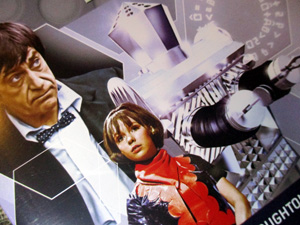The Krotons
“We’ve been slaves for a thousand years; do you think you can free us in one day?” – Beta
I originally dismissed The Krotons as a not very interesting episode, largely due to the clunky robots referenced in the title, but have had to re-evaluate after watching it a few times. It is after all a script by Robert Holmes, considered one of the best writers of the entire series. He actually builds a very interesting world—that of the Gonds, a once primitive race now in thrall to the unseen but superior Krotons who invaded their world thousands of years before. After defeating the Gonds’ initial attempt to repel the invasion, the Krotons became their seeming benefactors. Through teaching machines that “fill the mind with knowledge,” the Gonds had their culture and laws raised to a high level civilization. However, there are telling gaps in their knowledge. When the Doctor jokes about wishing he had an atomic laser rather than their axe, one Gond innocently asks “An atomic laser? Is that better than an axe?” Their knowledge of things like weapons and chemistry have been kept artificially low to keep them docile, their seeming benefaction actually being “a self perpetuating slavery” as the Doctor terms it. It becomes obvious that this whole story is really a fitting allegory of colonization.
Their entire society is undermined when the Doctor and friends reveal that the generations of top students sent to join the Krotons as companions have apparently been killed all along. He clues the Gonds in to the fact that the subjects the Krotons have kept them ignorant of are probably the very things needed to combat them. Internal strife complicates the response as some react with measured reason and some with self-serving haste, seeking to turn over the Doctor to save themselves. The Gonds have some great lines as they debate their situation: “It is not patriotism to lead people into a war they cannot win!” and “Don’t you think I want to discover truth for myself instead of being fed information like a dog with scraps?” In the end, however, the Doctor wins over the right people and they come to his rescue. (It’s interesting to see scenes in the beginning as the Second Doctor takes charge in a dithering and apologetic manner. It’s a very interesting contrast to the First Doctor’s style of haughtily commanding respect but accomplishes the same end.)
There are a lot of interesting science concepts used throughout this story too—the Krotons themselves are a mineral based lifeform that, like a virus, can revert to a basic elemental structure in stasis until needed. The entire living crystal ship (an interesting concept not exactly reflected in design) crash landed and for a few thousand years has been slowly educating and testing the Gonds trying to get them to the level of “high-brains” that will re-animate the Krotons. They drain mental energy which they are able to convert to useable power to regenerate and power their ship. The Doctor immediately recognizes the function of the force generator and circumvents it by having Zoe hold the end of chain to equalize the load. Even a new feature of the TARDIS (the Hostile Action Displacement System) that will be used again in the future is introduced.
While the Krotons show that Jamie is not exactly a “high brain,” he proves he still has bravery and cunning that allow him to outwit his captors. By far the best scene in the story, however, is the one where Zoe and the Doctor use the teaching machine. The quick fire lines of the Doctor and the humorous undercutting of the his brilliance is a perfect and funny Doctor/companion interaction. It’s really a well written story all together—simply let down by some less that stellar design.
Best (or worst) unsettling moments:
It’s quite eerie to hear the Krotons talk about Jamie so impersonally as they seize him. (“Have you damaged it?” “No, it is alive. Animal tissues is weak.”) Their casual “dispersal” of the “waste matter”–i.e. the students–is also unsettling. In terms of visuals, the scenes of the Doctor and Zoe undergoing the drain of the force generator is quite striking from the distorted perspective of their faces that we see.
Firsts:
- A living organic spaceship
- The HADS safety mechanism of the TARDIS
Regrets:
While the script is good and the story straightforward, a lot of the visuals are off-putting and ruin the effect. Not only that but the direction is lacking on several aspects too—there are many gaps where the characters in shot have nothing to do but stand their mugging for the camera while the others finish their lines (while in reality they would be taking action) or people have to ignore what we obviously see would be in their line of vision. It really undercuts believability.

